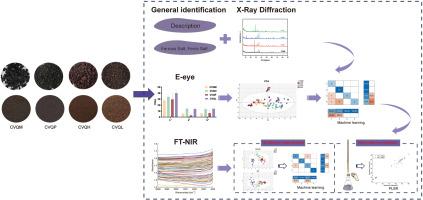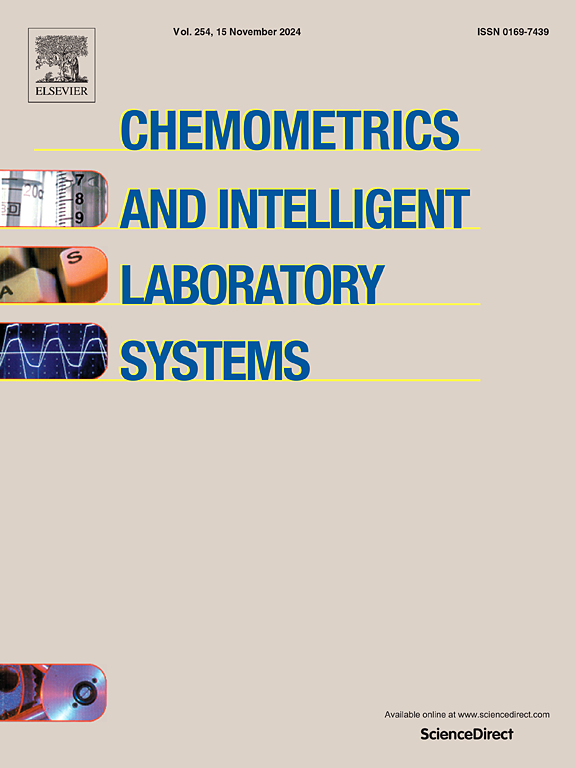FT-NIR结合多种智能算法快速识别定量分析铁矿物饮片
IF 3.8
2区 化学
Q2 AUTOMATION & CONTROL SYSTEMS
Chemometrics and Intelligent Laboratory Systems
Pub Date : 2025-08-26
DOI:10.1016/j.chemolab.2025.105512
引用次数: 0
摘要
烧醋淬磁铁矿(CVQM)、烧醋淬赤铁矿(CVQH)、烧醋淬黄铁矿(CVQP)、烧醋淬褐铁矿(CVQL)都是含铁矿物饮片,由于它们的主要成分和外观相似,很容易被混淆。然而,它们的药用价值差异很大,在临床环境中的滥用可能会给患者带来重大的安全风险。本研究采用E-eye和傅里叶变换近红外(FT-NIR)结合多元算法对这四种矿物饮片中的铁含量进行定性鉴定和定量预测。结果表明,PCA模型与带有E-eye的机器学习分类模型对四种饮片的区分无效,准确率低于80%。此外,通过利用FT-NIR技术对原始光谱进行SNV + ICO优化,我们实现了90%左右的机器学习分类模型准确率,与仅基于原始光谱的分析相比,准确率提高了28% - 36%。此外,定量预测回归(PLSR)模型预测铁含量的R2C = 0.9627, R2P = 0.9451,表明模型具有较强的线性和预测精度。综上所述,本研究表明FT-NIR结合多元算法为具有相似外观和成分的矿物药物的质量鉴定和评价提供了一种有效的方法。本文章由计算机程序翻译,如有差异,请以英文原文为准。

FT-NIR combined with multiple intelligent algorithms for rapid identification and quantitative analysis of Iron Mineral Decoction Pieces
Calcined and Vinegar-quenched Magnetite (CVQM), Calcined and Vinegar-quenched Hematite (CVQH), Calcined and Vinegar-quenched Pyrite (CVQP), Calcined and Vinegar-quenched Limonite (CVQL) are all iron-containing mineral decoction pieces, which are easily be confused because of their similar primary compositions and appearances. However, their medicinal values differ significantly, misuse in clinical settings could pose substantial safety risks to patients. In this study, E-eye and Fourier transform near infrared (FT-NIR) combined with multivariate algorithms were employed for the qualitative identification and quantitative prediction of iron content in these four kinds of mineral decoction pieces. The results indicated that the PCA model alongside machine learning classification models with E-eye was ineffective for distinguishing among the four types of decoction pieces, achieving an accuracy rate below 80 %. Furthermore, by utilizing FT-NIR technology with SNV + ICO optimization on raw spectra, we achieved machine-learning classification model accuracies around 90 %, which were improved by 28 %–36 % compared to analyses based solely on raw spectra. Additionally, the quantitative prediction regression (PLSR) model for predicting iron content demonstrated R2C = 0.9627 and R2P = 0.9451, indicating strong linearity and predictive accuracy of the model. Overall, this study demonstrated that FT-NIR combined with multivariate algorithms provided an effective approach for identifying and evaluating the quality of mineral medicines with similar appearances and compositions.
求助全文
通过发布文献求助,成功后即可免费获取论文全文。
去求助
来源期刊
CiteScore
7.50
自引率
7.70%
发文量
169
审稿时长
3.4 months
期刊介绍:
Chemometrics and Intelligent Laboratory Systems publishes original research papers, short communications, reviews, tutorials and Original Software Publications reporting on development of novel statistical, mathematical, or computer techniques in Chemistry and related disciplines.
Chemometrics is the chemical discipline that uses mathematical and statistical methods to design or select optimal procedures and experiments, and to provide maximum chemical information by analysing chemical data.
The journal deals with the following topics:
1) Development of new statistical, mathematical and chemometrical methods for Chemistry and related fields (Environmental Chemistry, Biochemistry, Toxicology, System Biology, -Omics, etc.)
2) Novel applications of chemometrics to all branches of Chemistry and related fields (typical domains of interest are: process data analysis, experimental design, data mining, signal processing, supervised modelling, decision making, robust statistics, mixture analysis, multivariate calibration etc.) Routine applications of established chemometrical techniques will not be considered.
3) Development of new software that provides novel tools or truly advances the use of chemometrical methods.
4) Well characterized data sets to test performance for the new methods and software.
The journal complies with International Committee of Medical Journal Editors'' Uniform requirements for manuscripts.

 求助内容:
求助内容: 应助结果提醒方式:
应助结果提醒方式:


